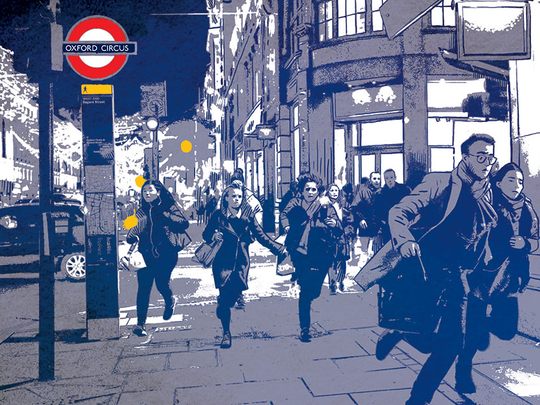
At 5.03pm on Friday, I received a WhatsApp message from my elder son to tell me he was just by Oxford Circus, that he thought there had been a terrorist incident, and that he wanted to know if I had heard anything. My blood ran cold.
By coincidence, I too was in the West End, hunched over my laptop before a meeting. So I took off immediately towards the shop where he had found refuge, running down Oxford Street towards the police cordons, against a tide of people hurrying anxiously in the opposite direction.
The air turned blue as I bumped into a few of them, wondering why the crazy guy with the beard was racing against the current towards whatever had (or hadn’t) happened. Please understand, there wasn’t a shred of courage in my mad dash: just the primal instinct of parenthood.
By the time I reached my son, the mood of collective panic was already melting into something closer to jumpy confusion. Helicopters buzzed overhead. Sirens wailed. Hundreds more spilled out on to the streets as the locked-down shops opened their doors. The traffic crawled grumpily around the northern fringes of Soho. Fear eased smoothly into humour.
Though 16 people were hurt in the crush, one suffering a nasty leg injury, there were no fatalities, no mutilated bodies on the pavement (as there were after the Westminster Bridge attack ) or nails in the faces of children (one of the many horrors of the Manchester Arena bombing ). The police and emergency services responded impeccably. There is much to be grateful for.
But what actually happened just after 4.30pm on Friday? Two men, aged 21 and 40, have handed themselves over to police after an apparent altercation at Oxford Circus tube station. This confrontation, it is now reported, escalated into full-blown panic as the rumour mill whirred into action, turbocharged in real time by social media. MailOnline had to apologise for circulating a tweet claiming that a lorry had mounted the pavement on Oxford Street with “police all around it and blood on the floor”. The tweet was not only incorrect but 10 days old.
Convergence technology has, of course, given us the smartphone as the defining device of our era — transforming what Mark Earls, in his masterly book Herd, calls “the physics of mass behaviour”. In his analysis of phenomena such as the responses to the death of Diana, Princess of Wales, and the Sydney riots of 2005 , Earls shows that most of what we do is “the result of the influence of other people, because we are a super-social species”. Much of what we think is product of individual purpose is in fact driven by emulation.
The under-explored question is whether, and in what circumstances, that emulation is reasonable. Here’s what I know: my 16-year-old, who is not inclined to embellishment, heard what sounded like gunshots. A backfiring car? A beam crashing into a skip at a nearby construction site? Possibly. But he also observed dozens of people fleeing Oxford Circus in mortal fear. I would still like to be told what he, and they, heard. Did the two-man “altercation” involve the discharge of weapons? The police said they had found no “evidence of shots fired”, which is not quite the same as saying that none were.
I even felt a batsqueak of sympathy for Olly Murs, who was pilloried online for tweeting from Selfridges to his 7.8 million followers an experience hundreds of others were going through. “Really not sure what’s happened!” the singer posted at 5.07pm. A little later he tweeted: “Being told no shots in Selfridges!”
Duty to stay silent
Some would say — some have — that a public figure in such a situation has a solemn duty to stay silent online until the police have made a statement. This strikes me as both unrealistic and unfair. Imagine the opprobrium that would have been heaped on Murs if the commotion he observed had indeed been triggered by a terrorist atrocity, and he had not used his digital clout to alert those in the area.
The events of Friday had much less to do with the follies of social media, or a fretful pop singer, or the fragility of the contemporary psyche, than the cold, harsh reality of 2017. To date this year, 36 people have died and hundreds more been injured in four terrorist attacks on British soil. In October, Andrew Parker, the director general of MI5, told the Guardian 20 plots had been thwarted in the last four years, and that there had been “ a dramatic upshift in the threat” from fundamentalist terrorism.
There is a morally shoddy yearning to avert our eyes from this simple fact and to focus instead on secondary issues: on immigration, on the ethics of giving terrorists the “oxygen of publicity”, on Islamophobia, on former prime minister Tony Blair’s alleged culpability for just about everything, on the failure of Twitter to provide as accurate a news service as the BBC.
On anything, in fact, rather than the truth that there has been a change in what it means to live in a British city, and accordingly in the way in which we respond collectively to danger — real, imagined, or somewhere in between. We oscillate between stoicism and fear. We remind ourselves of past attacks — the blitz, the IRA — and console ourselves that we endured and shall do so again. I like to think we will.
But it does nobody any favours to deny that the British urban experience today hums with a new sense of dread easily ignited into street mayhem by the slightest spark. There are good reasons why this is so, and we ignore them at our peril. It is a melancholy fact of modern life that, just occasionally, panic is the rational option.
— Guardian News & Media Ltd
Matthew d’Ancona is a Guardian columnist.








